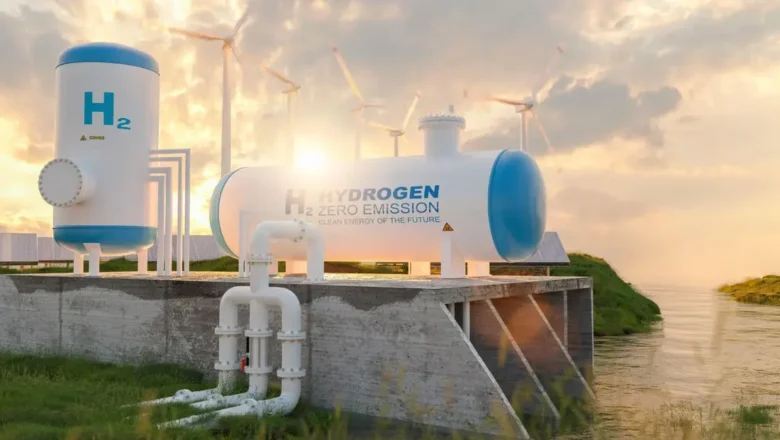Clean energy has become a priority for the 21st century as governments and industry work to develop alternatives to fossil fuels. Hydrogen has become the primary sustainable, renewable energy source due to its abundance, versatility, and low environmental impact. What makes hydrogen unique? Why is everyone hailing hydrogen as the next big player in clean energy? This blog explains the basics of hydrogen energy: how it is produced, its practical applications, and its potential to change the global energy landscape. This article explains hydrogen energy and its importance for a cleaner future for environmentalists and curious people.
Hydrogen Energy Basics:
Hydrogen energy uses hydrogen gas as its energy source. Water (H₂O) and many organic molecules contain hydrogen, the most abundant element in the universe. Hydrogen’s clean-burning properties make it a promising fuel. In a fuel cell, hydrogen is mixed with oxygen to produce electricity, leaving only water and heat. This feature makes hydrogen energy a carbon-free energy source that can reduce greenhouse gas emissions. While the environmental benefits of hydrogen energy are clear, the extensive processing and infrastructure required to convert it into energy have hindered its widespread use.
Hydrogen Methods: Details
There are many different methods for producing hydrogen, and the sustainability of each depends on how it is produced. There are three main methods for producing hydrogen: gray, blue, and green. Steam methane reforming produces gray hydrogen from natural gas. While efficient, this method releases large amounts of CO₂, negating the green potential of hydrogen. Blue hydrogen is a cleaner alternative that captures and stores CO₂ emissions through a CCS system, with natural gas as the primary source.
Finally, wind or solar energy electrolyzes water to produce hydrogen. This process, which splits water into hydrogen and oxygen, produces no CO₂ emissions and is the gold standard for sustainable hydrogen production. While green hydrogen is popular, it is the most expensive to produce due to the high costs of renewable energy and electrolysis.
Industrial Hydrogen Applications:
Many industries use hydrogen due to its adaptability. Hydrogen fuel cells power cars, buses, trains, and planes, making them a major application. FCEVs have a longer range and charge faster than pure electric vehicles, making them ideal for heavy-duty transportation.
In addition to transportation, hydrogen is transforming the industrial sector. Hydrogen is a cleaner way to reduce iron ore than fossil fuels used in steel production. Researchers are also exploring hydrogen as an alternative to natural gas for industrial heating and domestic use. Hydrogen is also used for energy storage. During periods of low demand, we can convert excess renewable energy to hydrogen and store it during peak demand. This capability makes hydrogen useful for stabilizing intermittent renewable energy systems.
Benefits of Clean, Sustainable Hydrogen:
Expected to transform the industrial landscape, hydrogen offers numerous benefits. The zero emissions of fuel cells are one of the advantages. Hydrogen is beneficial for the environment because it does not emit any pollutants or greenhouse gases. Another advantage is that it can be easily stored, transported, and used in various industries.
Hydrogen is abundant and can be produced locally, reducing energy imports and improving energy security. Hydrogen can be stored for long periods of time and complements intermittent and seasonal renewable energy sources such as solar and wind. Because of these properties, hydrogen is essential for the global transition to sustainable energy.
Barriers to Hydrogen Adoption:
Hydrogen has many benefits, but its widespread adoption is hampered by many factors. The cost of production is the most significant factor. Green hydrogen is the most sustainable option, but its production is prohibitively expensive due to the cost of electrolyzers and the requirements for renewable energy. Logistics are also complicated by a lack of infrastructure for storing, transporting, and distributing hydrogen.
Safety considerations remain a hurdle. Hydrogen is non-toxic but flammable, requiring strict regulations for storage and handling. Hydrogen fuel cells are less efficient than fossil fuels and require more technology to reach their full potential. Overcoming these barriers requires significant investment, policy support, and creativity.
Government and Industry Hydrogen Initiatives:
Given the potential of hydrogen, governments and companies worldwide are strongly promoting its use. The EU’s €470 billion hydrogen strategy aims to deploy 40 GW of green hydrogen electrolyzers by 2030. The US “Hydrogen Action” plan aims to reduce the price of clean hydrogen by 80% to $1 per kilogram within ten years.
Companies such as Toyota, Hyundai, and Shell have made outstanding strides in hydrogen technology. All parties are working together to build hydrogen hubs to centralize the production, storage, and transport of hydrogen, thereby promoting its use. As these projects progress, hydrogen will be integrated into the global energy grid.
Combining Hydrogen with Net-Zero Emissions:
Hydrogen is essential to achieving the global net-zero emissions target. Hydrogen-powered transport, industry, and power generation can replace fossil fuels. Hydrogen’s ability to store and transport renewable energy can contribute to the decarbonization of the energy system.
Hydrogen can reduce emissions in sectors such as aviation, shipping, and industrial activities that cannot be electrified. A global hydrogen economy could help limit global warming to 1.5°C above pre-industrial levels, in line with the Paris Agreement.
Future Trends and Innovations in Hydrogen Technology:
Hydrogen production, storage, and applications are developing rapidly. New electrolysis technologies are driving down the cost of green hydrogen, while solid-state storage materials hold promise for safer, more efficient hydrogen transport.
Hydrogen systems are becoming more efficient when combined with artificial intelligence and the Internet of Things. Hydrogen microgrids and hydrogen-natural gas hybrids are also gaining popularity. These developments will strengthen hydrogen’s role in the clean energy transition.
Emerging Clean Hydrogen Energy:
Hydrogen may be the “most valuable” (MVP) of clean energy. It is unmatched in its ability to transform and decarbonize hard-to-reduce industries, and integrate renewable energy. To realize its full potential, significant efforts are needed to reduce production costs and build infrastructure.
Hydrogen’s importance in sustainable energy is growing as governments, industries, and inventors support it. As a policymaker, business leader, or environmentalist, supporting hydrogen initiatives can help you clean up the planet. We can harness the power of hydrogen to create a sustainable future.
FAQs:
1. What is hydrogen?
Fuel cells use hydrogen to generate clean electricity, producing only water and heat.
2. How is hydrogen produced?
Steam methane reforming, water electrolysis, and biomass gasification can all produce hydrogen, with green hydrogen being the most sustainable.
3. What are the main uses of hydrogen?
Hydrogen is needed for transportation, industry, energy storage, and power generation.
4. Why is green hydrogen expensive?
Green hydrogen is expensive because electrolyzers and renewable energy are expensive.
5. Is hydrogen safe?
Hydrogen is non-toxic, but it is flammable, which requires strict safety procedures for storage and transportation.




